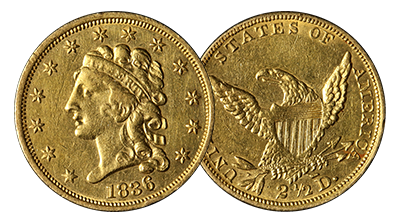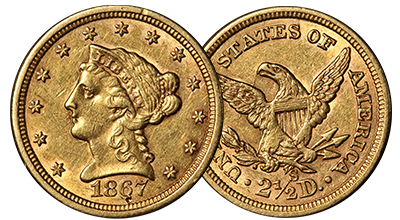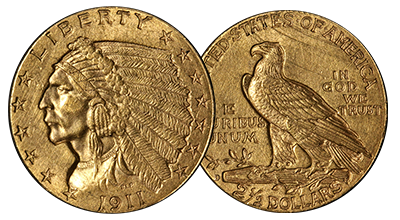U.S. Gold Coins: $2.5 Gold Coins FAQs
There are seven distinct designs of the $2.5 gold coin, commonly known as the "Quarter Eagle":
Capped Bust to Right, No Stars (1796)
Capped Bust to Right, With Stars (1796-1807)
Capped Bust to Left (1808)
Capped Head to Left (1821-1834)
Classic Head (1834-1839)
Liberty Head (1840-1907)
Indian Head (1908-1929)
Yes, the different designs of the $2.5 gold coin, or the "Quarter Eagle," were created by various designers over the years. Here's a breakdown of the designs and their respective designers:
Capped Bust to Right, No Stars (1796) & Capped Bust to Right, With Stars (1796-1807):
Designer: Robert Scot
Scot was the Chief Engraver of the U.S. Mint at the time and is responsible for several early U.S. coin designs.
Capped Bust to Left (1808):
Designer: John Reich
Reich was an assistant engraver at the U.S. Mint and introduced various design modifications to U.S. coins.
Capped Head to Left (1821-1834):
Designer: John Reich (initial design) with modifications by Chief Engraver William Kneass.
Kneass became Chief Engraver after Scot and made modifications to some of Reich's designs.
Classic Head (1834-1839):
Designer: William Kneass
This design was a significant departure from the previous designs and was introduced to reflect the change in gold content in the coin.
Liberty Head (1840-1907):
Designer: Christian Gobrecht
Gobrecht became the Chief Engraver after Kneass and introduced the Liberty Head design, which was used on various denominations.
Indian Head (1908-1929):
Designer: Bela Lyon Pratt
Pratt's design was unique in that it was incuse, meaning the design was sunken into the surface of the coin rather than raised. This design choice was quite distinctive and was also used on the $5 Indian Head Half Eagle.
Different periods and changing aesthetics influenced the designs, and the U.S. Mint often employed different engravers and artists to bring fresh perspectives to coinage.
The $2.5 gold coin, known as the "Quarter Eagle," was produced at six U.S. Mint facilities over its long history. Specifically, the Quarter Eagle was minted at the following locations:
Philadelphia Mint (P or no mintmark): The primary mint facility, located in Philadelphia, Pennsylvania, produced Quarter Eagles for the entire duration of the coin's production.
Charlotte Mint (C mintmark): Located in Charlotte, North Carolina, this mint produced Quarter Eagles from 1838 to 1861. It primarily minted gold coins using gold sourced from the southern states.
Dahlonega Mint (D mintmark): Situated in Dahlonega, Georgia, this mint produced Quarter Eagles from 1839 to 1861, also using locally sourced gold.
New Orleans Mint (O mintmark): Located in New Orleans, Louisiana, this mint produced Quarter Eagles intermittently between 1839 and 1857.
San Francisco Mint (S mintmark): Situated in San Francisco, California, this mint began operations in 1854 and produced Quarter Eagles in various years from its inception until 1915.
Denver Mint (D mintmark): Located in Denver, Colorado, this mint produced Quarter Eagles starting in the early 20th century, specifically from 1906 to 1911 and then again in 1925 and 1926.




